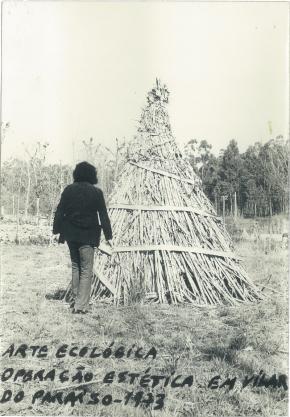Rural topographies
 Alberto Carneiro’s notes for a manifesto of ecological art were originally penned as entries in his diary between December 1968 and February 1972. This is a distant past, pre-Chernobyl and long before the term ‘permaculture’ was coined or the effects of accelerated climate change could be felt. While we are witnessing increasing urbanisation artists have also sought out the rural realm as a source of inspiration. Rural Topographies | Topografias Rurais presents analogies between the work of Alberto Carneiro and three artists from different generations and geographical contexts: Ana Lupas, Lala Meredith-Vula and Claire de Santa Coloma.
Alberto Carneiro’s notes for a manifesto of ecological art were originally penned as entries in his diary between December 1968 and February 1972. This is a distant past, pre-Chernobyl and long before the term ‘permaculture’ was coined or the effects of accelerated climate change could be felt. While we are witnessing increasing urbanisation artists have also sought out the rural realm as a source of inspiration. Rural Topographies | Topografias Rurais presents analogies between the work of Alberto Carneiro and three artists from different generations and geographical contexts: Ana Lupas, Lala Meredith-Vula and Claire de Santa Coloma.
The exhibition is divided into two chapters, covering a variety of media employed by Alberto Carneiro. Celebrating its fortieth birthday this year, Cooperativa Diferença (where Carneiro was a member and held solo shows in 1979 and 1981) presents a series of graphite drawings produced towards the end of the artist’s career and which have never been exhibited before. These works hint at the immediate surroundings of his studio and the hilly landscapes of Northern Portugal. Also presented are three triptychs produced by pressed flower petals that were plucked by Carneiro from plants in his garden in São Mamede do Coronado near Porto.
The second exhibition chapter at Galeria Quadrum (where Carneiro held five solo exhibitions between 1975 and 1983) evokes Carneiro’s performative gestures. Like the raft of the medusa, installed at the centre of the gallery space, one encounters Metáforas da agua ou as naus a haver por mares de antes navegados, (Metaphors of water or, The ships yet-to-be by oceans where none have ventured, 1993-1994) alongside works and documentation stemming from his Operação estetica em Vilar do Paraíso (Aesthetic Operation in Vilar do Paraíso, 1973), which was performed during March 1973 near Vila Nova de Gaia.
Claire de Santa Coloma’s work references Carneiro as well as Romanian-French sculptor Constantin Brâncuși. For Santa Coloma, the process of sculpting is an act of resistance. Situated within the urban, her daily work routines allude to those of a farmer or craftsman. The practice of chiselling appears to be almost therapeutic and decidedly spiritual.
Ana Lupas created her fodder sculptures mostly in the form of wreaths and in collaboration with the communities of Transylvanian villages. Conceived in 1964 for an exclusively rural environment, The Solemn Process consists of a series of prototypical corporeal structures of various dimensions made of perishable materials such as wheat straw, hemp, cotton, wood and metal.
Finally, Lala Meredith-Vula’s photographs from the Haystacks series (1989 -ongoing) are also set within an Eastern European context that is far from homogenous and which is still battling the turmoil brought about by the dissolution of authoritarian regimes following the fall of the iron curtain thirty years ago in 1989.
If Lupas suffered repression when creating works during the communist era from the mid-1970s onwards and collaborated with many locals for her sculptures, Meredith-Vula’s decade long research and portrayal of haystacks also brought her closer to the people of her father´s native Albania.
Viewers can consider the artistic positions as similar in form yet different in historical conception. They create a network of different approaches to the rural and simultaneously call attention to ecological concerns. The works constitute potent signifiers within a global discourse of regionalism as well as representing a call to (poetic) action within our natural environment.
Alberto Carneiro (São Mamede de Coronado, 1937 – Porto 2017) was a Portuguese artist.
Ana Lupas was born in Cluj in 1940. She lives and works in Cluj.
Lala Meredith-Vula was born in Sarajevo in 1966. She lives and works in Leicester.
Claire de Santa Coloma was born in Buenos Aires in 1983. She lives and works in Lisbon.
Gallery hours at Quadrum are from Tuesday to Friday, 2.30 - 7pm and on weekends between 10am - 1pm and from 2 - 6pm. Galeria Diferença: Tuesday to Friday 2 - 7pm and Saturdays from 3 – 8pm.
Galeria Diferença and Galerias Municipais acknowledge the support of Fundação Carmona e Costa towards the forthcoming publication.